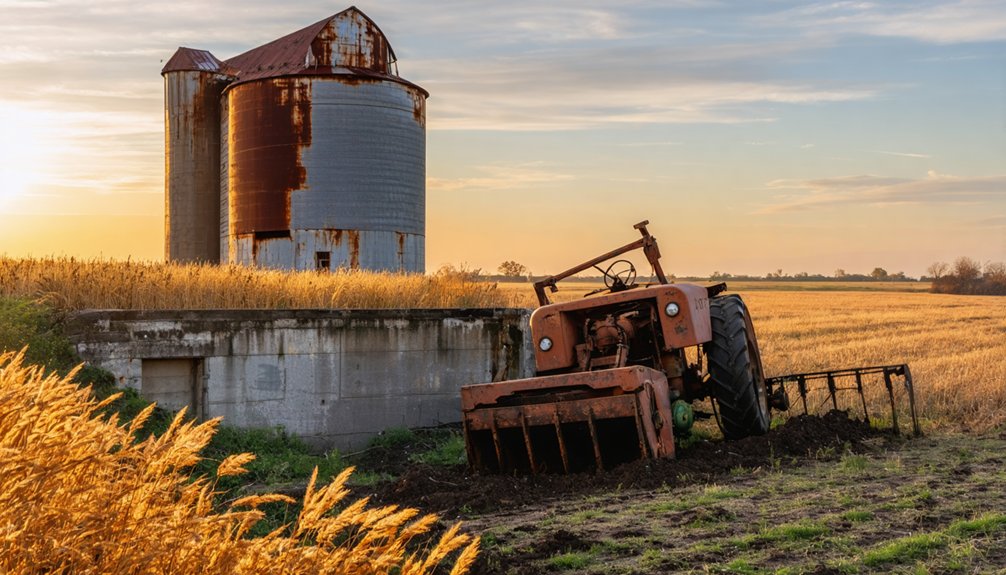You’ll find Donnan’s remains in Fayette County, Iowa, where this once-thriving farming settlement was established in 1874. Today, a memorial sign marks the location 6 miles from West Union and 8 miles from Hawkeye, accessible via U.S. Route 63 and rural roads. The ghost town‘s most notable feature is its weathered railroad station sign, while the Fayette County Museum houses artifacts from Donnan’s agricultural heyday. The site’s rich history holds countless stories of Iowa’s rural past.
Key Takeaways
- Donnan was established in 1874 as a farming settlement in Fayette County, Iowa, but is now considered a ghost town.
- The town’s decline occurred due to improved transportation and population loss to nearby larger cities.
- A memorial sign and remnants of an old railroad station are the main visible historical landmarks remaining.
- The Fayette County Museum maintains a dedicated Donnan room with artifacts preserving the town’s history.
- The site is accessible via rural roads from Fayette, with best visiting conditions from late May through September.
The Rise and Fall of Donnan
While many Iowa towns flourished during the railroad era of the late 1800s, Donnan’s story began in 1874 when it was established as a farming settlement in Fayette County. Today, only a memorial sign remains to mark where this once-thriving community existed. Like the former town of West Le Mars, Donnan declined as transportation improvements and nearby larger cities drew residents away.
Life in Rural Iowa’s Past
Beyond the railroad tracks and scattered farmsteads, life in rural Iowa during the late 1800s and early 1900s centered on the demanding routines of farm families, especially women.
You’d find rural women’s roles extending far beyond typical household duties – they’d manage extensive chores like manual clothes washing, sewing family garments, and preparing meals while also tending gardens, preserving food, and caring for livestock. When necessary, they’d even run entire farm operations solo. Local organizations like the Daughters of Ceres provided critical social and benevolent support for these hardworking farmwomen. Families stored their preserved goods and harvested crops in root cellars for year-round use.
Despite geographic isolation, you’d discover vibrant community connections through social visits, church activities, and women’s organizations like the Cedar Valley Community Club.
With the arrival of technological advances such as automobiles and improved household appliances, you’d notice rural life becoming more efficient and connected, though education often remained basic, with local schools providing essential literacy and arithmetic skills.
Getting to Donnan Today
You’ll find the most reliable access to Donnan via rural roads connecting from nearby Fayette, though you’ll want to prepare your route using GPS coordinates since there’s minimal signage marking the ghost town’s location.
Your best approach involves taking maintained county roads as far as possible before shifting to any necessary off-road exploration of the former townsite.
When planning your visit, you’ll need to account for seasonal conditions, as autumn and winter weather can make unpaved access routes particularly challenging to navigate. Just as ion distribution affects membrane permeability in chemistry, the site’s accessibility is heavily influenced by environmental conditions.
The abandoned settlement represents one of several former populated places in Iowa that provide valuable insights into the state’s past development patterns.
Best Access Routes Available
Reaching the former site of Donnan, Iowa, requires careful navigation through a network of rural roads in Fayette County‘s gently rolling farmland.
You’ll find the most direct access routes from nearby towns like West Union (6 miles via County Road C57/B58) or Hawkeye (8 miles via B44/B58). For local navigation, you won’t find official signage, so rely on GPS coordinates (42°53’54″N, 91°52’37″W) and satellite mapping.
If you’re coming from farther away, take U.S. Route 63 as your main approach, then connect to county roads. This route follows near where the Chicago, Milwaukee & St. Paul Railroad once operated through the area. The area represents one of many Midwest farm communities that declined due to economic challenges.
While the roads are well-maintained, they’re typical rural Iowa thoroughfares – narrow and mostly gravel. During winter, you might need snow tires or 4WD.
Watch for farmsteads and rural crossroads as reference points, since the former city site remains unmarked.
Seasonal Travel Planning Tips
Now that you know how to reach Donnan, planning your visit around seasonal conditions will help guarantee a successful trip.
Since you’ll need to drive on rural roads with potentially challenging conditions, understanding seasonal travel safety is essential for accessing this remote ghost town location.
- Spring through early fall offers the most reliable travel conditions, but pack rain gear and sturdy boots for muddy terrain.
- Bring offline maps or GPS devices, as cell coverage can be unreliable in all seasons.
- During winter months, equip your vehicle with snow tires or chains, and plan trips between late morning and mid-afternoon.
- Check Fayette County road conditions and weather forecasts before departing, especially during planting and harvest seasons when farm equipment frequently uses access routes.
What Remains: A Visual Journey
Today’s visual remnants of Donnan, Iowa tell a story of rural decline through scattered physical artifacts. As you explore New Donnan Road, you’ll encounter a handful of surviving buildings and an old railroad station sign that marks the community’s railroad heritage. For proper disambiguation and navigation, signs now mark key historic locations to help visitors identify the authentic remnants of old Donnan from newer structures.
A commemorative monument stands as a silent sentinel, offering photographic opportunities that capture the town’s evolution from vibrant community to ghost town. The town reached its zenith with a peak population of 50 before its gradual decline.
For visual documentation, you’ll find the most compelling shots at dawn or dusk when the light plays across the few remaining structures. The flat Midwestern landscape, now dominated by farmland where streets once ran, creates a stark backdrop.
While nature reclaims much of the former townsite, the Fayette County Museum‘s Donnan room preserves tangible pieces of this vanished community’s story.
Best Times to Visit

You’ll find peak fall colors transforming Donnan’s landscape from late September through mid-October, when the surrounding woodlands burst into brilliant reds, oranges, and yellows.
The gravel and dirt roads leading to Donnan remain most reliably passable from April through November, barring heavy rainfall that could create muddy conditions.
While winter’s snow and spring’s occasional flooding can limit access, autumn’s moderate temperatures and stable ground conditions make it the ideal season for exploring this Iowa ghost town.
Fall Colors Peak
While fall colors transform Iowa’s landscape in predictable patterns each autumn, the peak viewing times vary considerably by region.
When you’re planning your visit to Donnan’s ghost town remnants, you’ll want to time your trip with eastern Iowa’s stunning fall foliage display, typically reaching its peak from early to mid-October.
To maximize your autumn activities around Donnan:
- Track the progression of sugar maples turning vibrant orange and red
- Watch for sumac and dogwood, which provide early splashes of crimson
- Follow Travel Iowa’s scenic drive recommendations through the area
- Visit during cool, sunny days when the colors are most vivid
The local walnut and elm trees turn golden yellow, creating a perfect backdrop for exploring this historic ghost town site.
Road Accessibility Seasons
Beyond the spectacular fall colors, accessing Donnan’s historic remains requires careful consideration of Iowa’s seasonal road conditions.
You’ll find the most reliable road access from late May through September, with July and August offering ideal driving conditions on the rural routes leading to this ghost town.
The unpaved county roads around Donnan respond dramatically to seasonal weather changes.
Spring’s thaws create muddy challenges, while winter’s snow and ice make the journey treacherous.
You’ll need a high-clearance vehicle during wet seasons, and four-wheel drive is essential for winter visits if you’re determined to brave the elements.
Summer’s dry conditions welcome standard vehicles, though you should still watch for rough patches from farm equipment use.
For the safest, most comfortable exploration, plan your visit during the warm, dry months.
Historical Landmarks and Buildings
Among the few remnants of Donnan’s past, the former railroad station sign stands as the most notable historical landmark in this Iowa ghost town. The sign’s historical significance lies in its direct connection to the town’s railroad heritage, marking a location that once bustled with activity.
You’ll discover these key architectural features and elements:
- Original railroad station signage with weathered lettering
- Metal construction typical of early 20th-century railroad infrastructure
- Mounting brackets that showcase period-specific engineering
- Historical placement along the former railway route
The sign serves as a solitary sentinel of Donnan’s bygone era, representing the crucial role railroads played in Iowa’s rural development.
It’s one of the few tangible links to the town’s transportation history that you can still observe today.
Agricultural Legacy

Corn and wheat fields once defined Donnan’s agricultural identity, with the town’s economy centered on small-scale family farming typical of Iowa’s rural landscape in the late 19th and early 20th centuries.
You’ll find evidence of farming traditions in the division of labor, where wives managed livestock and households while men handled fieldwork and business dealings.
The town embraced agricultural innovations between 1900 and 1940, as farmers adopted new technologies and mechanization to enhance productivity.
You can trace Donnan’s prosperity through its rail connections, which opened broader markets for crops and livestock.
While the town’s physical presence has diminished, its agricultural legacy lives on through preserved artifacts at the Fayette County Museum, telling the story of a community that adapted to changing times while maintaining its farming heritage.
Preserving Donnan’s Memory
The physical legacy of Donnan persists through carefully placed memorials and preserved artifacts, even as its farmlands return to nature.
You’ll find tangible reminders of this once-thriving community preserved in several ways:
- A monument stands proudly on New Donnan Road, while a 1978 centennial plaque marks the town’s century of existence before its decline.
- The Fayette County Museum’s dedicated Donnan room houses community artifacts and documents, safeguarding the town’s material heritage.
- Oral histories captured through newspaper interviews, including Mayor Matt Porter’s reflections on the town’s final days.
- Commemorative postal covers from 1982 and official records of the 1990 disincorporation vote (6-1) provide precise documentation of Donnan’s evolution from township to ghost town.
Frequently Asked Questions
Are There Any Ghost Stories or Paranormal Activities Reported in Donnan?
You won’t find documented haunted locations or local legends in Donnan. Despite its ghost town status, there aren’t any verified paranormal activities or supernatural stories recorded from this abandoned Iowa settlement.
What Happened to the Original Residents When They Left Donnan?
Like the Johnson family who moved to Waterloo in 1952, most original residents left for bigger cities. You’ll find they scattered across Iowa seeking better jobs, while others relocated to nearby farming communities.
Is Permission Required From Landowners to Explore the Site?
Yes, you’ll need landowner permission for legal land access since the site is private property. Ignoring these legal considerations could result in trespassing charges under Iowa state law.
Were Any Movies or Television Shows Ever Filmed in Donnan?
No, you won’t find any Donnan films or Donnan documentaries ever made there. While Iowa has hosted productions like “Field of Dreams,” this ghost town hasn’t been used for filming purposes.
Does Anyone Maintain Genealogical Records of Former Donnan Families?
You’ll find genealogical resources at Fayette County Museum’s dedicated Donnan Room and through Iowa’s statewide databases. Local historical societies and FamilySearch.org maintain family histories from this vanished community.
References
- https://www.onlyinyourstate.com/trip-ideas/iowa/ghost-town-ia
- https://www.geotab.com/ghost-towns/
- https://b100quadcities.com/six-ghost-towns-in-iowa/
- https://en.wikipedia.org/wiki/List_of_ghost_towns_in_Iowa
- https://kids.kiddle.co/List_of_ghost_towns_in_Iowa
- https://ouriowaheritage.com/jc-ghost-towns/
- https://www.radioiowa.com/2025/07/15/stories-of-northwest-iowa-ghost-town-come-to-life-in-new-book/
- https://www.discoverguthriecounty.org/ghosttowns
- https://guides.lib.uiowa.edu/c.php?g=1250461&p=9155002
- http://www.iowapbs.org/iowapathways/mypath/2583/farm



